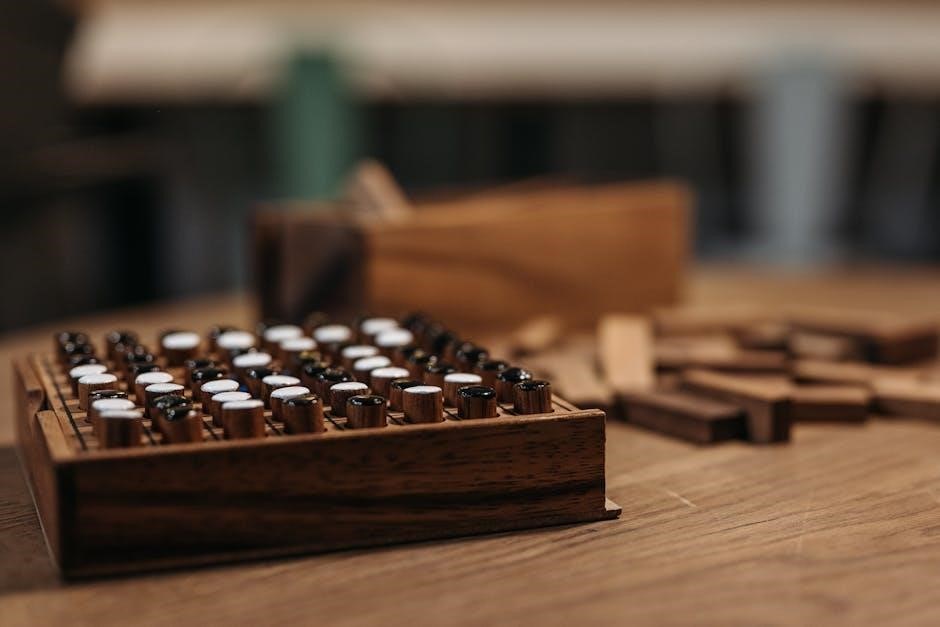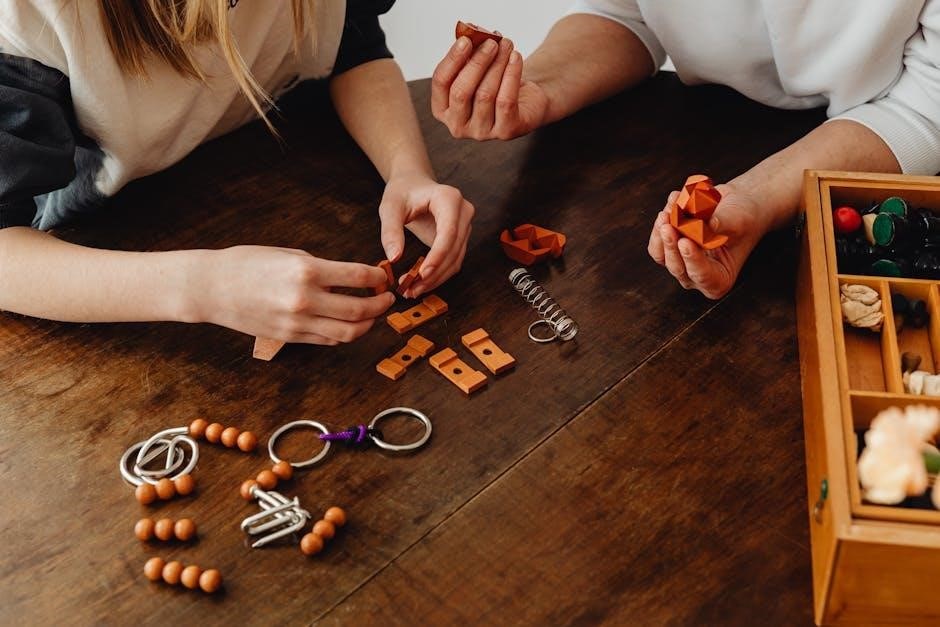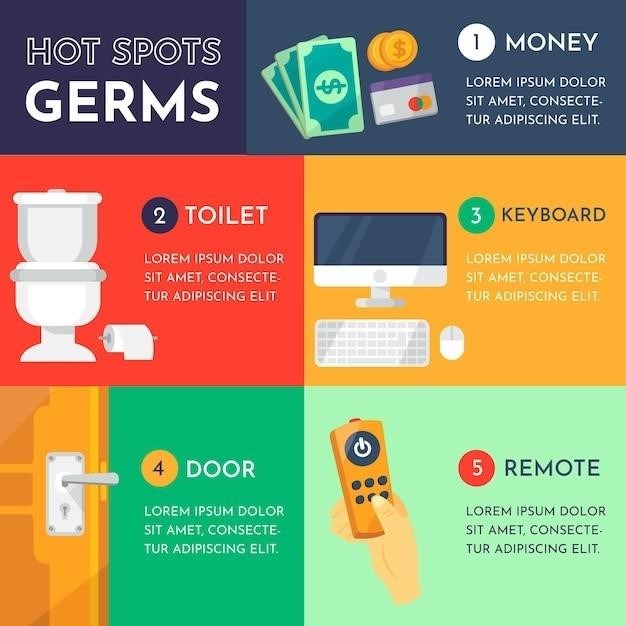The periodic table crossword puzzle is an engaging educational tool that combines fun with learning‚ helping students master element names‚ symbols‚ and their positions effectively.
Overview of the Periodic Table Crossword Puzzle
The periodic table crossword puzzle is an interactive learning tool designed to engage students with chemistry concepts. It combines element names‚ symbols‚ and their positions in the periodic table‚ offering a fun way to reinforce knowledge. The puzzle includes across and down clues‚ covering various aspects like atomic numbers‚ groups‚ and periods. By solving the crossword‚ learners improve their understanding of element classification and relationships. The answer key‚ available in PDF format‚ provides solutions for verification. This resource is particularly useful for high school and university students‚ making complex chemistry topics more accessible and enjoyable through gamified learning.
Importance of Crossword Puzzles in Learning Chemistry
Engaging with crossword puzzles is a highly effective way to enhance chemistry learning‚ particularly for concepts like the periodic table. These puzzles make complex information more accessible and fun‚ encouraging active participation. By focusing on element names‚ symbols‚ and their positions‚ students improve retention and understanding. Crosswords also foster problem-solving skills and logical thinking‚ which are essential in chemistry. Additionally‚ they cater to visual and kinetic learners‚ providing a hands-on approach to mastering the periodic table. The availability of answer keys in PDF formats ensures students can verify their progress‚ making crosswords a valuable tool for self-assessment and deeper comprehension of chemistry principles.

Structure of the Periodic Table Crossword Puzzle
The crossword features a grid with Across and Down clues‚ focusing on element symbols‚ names‚ and their positions in the periodic table‚ enhancing learning through interactive problem-solving.
Across and Down Clues in the Crossword
The crossword puzzle is structured with Across and Down clues‚ each linking to specific elements‚ their symbols‚ or positions in the periodic table. Across clues often focus on element names‚ groups‚ or periods‚ while Down clues might target symbols‚ atomic numbers‚ or chemical properties. For example‚ an Across clue might ask for “Group 1 metals‚” while a Down clue could request the symbol for “Helium.” These clues are designed to test knowledge of element classification and relationships‚ making the puzzle both educational and engaging. The interplay between clues challenges learners to think critically about the periodic table’s structure and content‚ fostering a deeper understanding of chemistry concepts. The balance of straightforward and more complex clues ensures the puzzle is accessible yet intellectually stimulating for students of all levels. By solving these clues‚ participants reinforce their familiarity with the periodic table‚ enhancing retention and recall of key element information.
Key Elements and Their Positions
Identifying key elements and their positions is crucial for solving the crossword puzzle. Elements like Hydrogen (H)‚ Helium (He)‚ Oxygen (O)‚ and Iron (Fe) are frequently featured due to their prominence in the periodic table. Elements such as Carbon (C) and Nitrogen (N) often appear in clues related to organic chemistry and life sciences. The positions of these elements‚ such as Hydrogen being in Group 1 and Period 1‚ or Helium in Group 18 and Period 1‚ are essential for answering clues accurately. By focusing on these key elements‚ solvers can systematically fill in the crossword‚ leveraging their knowledge of the periodic table’s layout. This approach helps build familiarity with the table’s structure and enhances understanding of element relationships. Regular practice with such puzzles reinforces memory of element positions‚ making it easier to tackle more complex chemistry problems in the future. The strategic placement of these elements ensures that the crossword remains both challenging and educational‚ catering to learners at various stages of their chemistry education. The process of locating and placing these elements in the crossword grid mimics the logical arrangement of the periodic table itself‚ reinforcing foundational chemistry concepts in an engaging manner.
Group and Period Identification in the Puzzle
Identifying groups and periods in the crossword puzzle enhances understanding of the periodic table’s structure. Clues often reference groups‚ such as Group 7 (reactive non-metals like fluorine) or Group 2 (reactive metals like magnesium). Periods are also highlighted‚ with questions about elements in specific rows‚ like Period 2 or 3. This focus helps learners recognize patterns‚ such as the Noble Gases in Group 18 or Transition Metals across periods. By linking elements to their groups and periods‚ the puzzle reinforces periodic trends and chemical properties‚ making it a valuable tool for mastering chemistry fundamentals. This skill is especially beneficial for students and educators alike‚ as it bridges fun and learning seamlessly.

Key Features of the Periodic Table Crossword Puzzle
The crossword incorporates element symbols‚ atomic numbers‚ and names‚ challenging users to connect clues with periodic table positions‚ enhancing understanding of chemical properties and trends effectively.
Symbol and Name Matching
One of the core features of the periodic table crossword puzzle is the integration of element symbols and their corresponding names. This interactive approach challenges learners to connect clues with their chemical identities. For instance‚ hydrogen (H) and helium (He) are matched with their atomic numbers and positions. The puzzle often includes clues like “Symbol for gold” (Au) or “Name of element 12” (Magnesium). This feature enhances memory retention by requiring users to link symbols with names‚ fostering a deeper understanding of the periodic table’s structure and element properties across different groups and periods.
Atomic Number and Element Address
The crossword puzzle incorporates atomic numbers and element addresses‚ enhancing learners’ understanding of the periodic table’s organizational structure. Clues often reference atomic numbers‚ such as “Element with atomic number 6” (Carbon)‚ or addresses like “Group 2‚ Period 2” (Magnesium). By matching these numerical identifiers with element names or symbols‚ students reinforce their knowledge of the periodic table layout. This feature bridges theoretical concepts with practical application‚ making the learning process engaging and effective for memorizing element positions and their relationships.
Reactivity and Group Characteristics
The crossword puzzle highlights reactivity and group characteristics‚ enabling learners to connect elements with their chemical properties. Clues often reference group traits‚ such as “Group 1 metals are highly reactive” or “Noble gases are inert.” This feature helps students understand how elements within the same group or period share similar behaviors‚ fostering insights into periodic trends. By linking reactivity patterns to specific groups‚ the puzzle reinforces key concepts like metallicity‚ non-metallicity‚ and the unique properties of transition metals. This approach makes learning engaging while deepening the understanding of elemental relationships and their chemical behaviors.

How to Solve the Periodic Table Crossword Puzzle
Solving the crossword involves referencing the periodic table to identify elements‚ their symbols‚ and positions. Start by matching known elements‚ then use group and period trends to find connections. Begin with easy clues like noble gases or alkali metals‚ and progress to less familiar elements. This method ensures a logical and enjoyable learning experience‚ enhancing chemistry knowledge through interactive practice.
Using the Periodic Table as a Reference
The periodic table is the primary tool for solving the crossword puzzle. Start by identifying element symbols and their corresponding names‚ then locate their positions by group and period. For example‚ Group 1 metals like lithium (Li) or sodium (Na) can be matched with Across clues‚ while noble gases like helium (He) or neon (Ne) often appear in Down clues. Use atomic numbers to confirm element addresses‚ such as hydrogen (H) at 1 or uranium (U) at 92. This systematic approach ensures accuracy and helps learners connect clues to their chemical properties effectively.
Identifying Element Symbols and Names
Identifying element symbols and names is crucial for solving the crossword puzzle. Start by matching clues to known symbols‚ such as H for hydrogen or He for helium. Cross-referencing with the periodic table helps confirm names and symbols‚ ensuring accuracy. For instance‚ the symbol Cd corresponds to cadmium‚ while the name neon matches Ne. This process reinforces memory of elements and their representations‚ aiding in completing the puzzle efficiently. Accuracy is key‚ as incorrect matches can lead to confusion in subsequent clues‚ making it essential to verify each element’s identity carefully.
Understanding Group and Period Trends
Understanding group and period trends is essential for solving the crossword puzzle. Groups (vertical columns) share similar properties‚ such as alkali metals in Group 1 or noble gases in Group 18. Periods (horizontal rows) indicate the principal quantum number‚ reflecting atomic size trends. For example‚ elements in Period 2 are smaller than those in Period 3. Clues often reference these trends‚ such as “Group 2 metals” or “Period 4 non-metals.” Recognizing these patterns helps narrow down possible answers‚ making the puzzle more manageable and educational. This knowledge also deepens understanding of the periodic table’s structure and element relationships.

Tips for Creating an Effective Crossword Puzzle
Ensure clues are clear and engaging‚ balancing difficulty for all learners. Use accurate element data and organize the grid logically to enhance the learning experience effectively.
Designing Clues for Maximum Engagement
Crafting compelling clues is essential for an engaging crossword experience. Clues should be clear yet challenging‚ encouraging learners to think critically about element properties and positions. Incorporating various clue types‚ such as definition-based or position-related hints‚ can cater to different learning styles. Using real-world applications or interesting facts about elements can also enhance interest. Additionally‚ ensuring a balance between straightforward and more complex clues helps maintain a steady flow‚ keeping participants motivated and eager to solve the puzzle. This approach fosters both enjoyment and a deeper understanding of the periodic table.
Ensuring Accuracy in Element Information
Accuracy is crucial when designing a periodic table crossword puzzle. Each clue and answer must align precisely with the periodic table’s official data‚ ensuring element names‚ symbols‚ and positions are correct. To achieve this‚ cross-referencing with reliable sources‚ such as the IUPAC periodic table‚ is essential. Double-checking atomic numbers‚ group classifications‚ and period placements helps prevent errors. Using standardized abbreviations and terminology avoids confusion. Additionally‚ consulting educational resources or chemistry experts can validate the information. This meticulous approach ensures the crossword is both educational and reliable‚ making it an effective learning tool for students of all levels.
Balancing Difficulty Levels for Different Learners
Balancing difficulty levels in a periodic table crossword puzzle ensures it caters to diverse learners‚ from beginners to advanced students. For younger learners‚ clues can focus on basic element names and symbols‚ while more challenging puzzles incorporate complex atomic structures or periodic trends. Mixing straightforward questions with harder ones keeps the puzzle engaging for all skill levels. Including visual aids or hints for tricky elements can also bridge knowledge gaps. By tailoring the difficulty‚ educators can ensure the crossword is both educational and enjoyable‚ fostering a deeper understanding of chemistry concepts for learners of all backgrounds and abilities.

PDF Resources for the Periodic Table Crossword
PDF resources offer downloadable crossword templates and answer keys‚ enabling easy access and printing for classroom or self-study use‚ enhancing learning with structured puzzles and solutions.
Downloading the Answer Key
Downloading the answer key for the periodic table crossword puzzle is a straightforward process‚ with many resources available online as PDFs. These documents provide clear solutions to all clues‚ ensuring accuracy and ease of verification. Educational websites and chemistry resource platforms often host these files‚ making them accessible to students and educators alike. By searching for “periodic table crossword puzzle answer key PDF‚” users can quickly locate and download the necessary materials. These keys are particularly useful for self-assessment and ensuring that all answers align with the periodic table’s structure. They also serve as valuable tools for validating responses and deepening understanding of element properties and positions.
Accessing Printable Crossword Templates
Accessing printable crossword templates for the periodic table is convenient and straightforward. Many educational websites and chemistry resource platforms offer free‚ downloadable PDF templates designed to help students engage with the periodic table in an interactive way. These templates often include clues related to element names‚ symbols‚ and their positions‚ making them ideal for classroom activities or self-study. Users can search for “periodic table crossword puzzle template PDF” to find a variety of options tailored to different learning levels. These printable templates are a great way to reinforce knowledge of the periodic table while enjoying the puzzle-solving experience.
Locating Solutions for Common Crossword Puzzles
Locating solutions for common crossword puzzles related to the periodic table is made easy through online resources and educational platforms. Websites specializing in crossword answers provide detailed solutions‚ including element names‚ symbols‚ and their positions. For instance‚ clues like “Element below helium” or “Group 7 reactive non-metals” can be quickly resolved by referencing these online tools. Additionally‚ forums and chemistry-focused communities often share answer keys and hints to help users complete their puzzles accurately. Many PDF resources also include solutions alongside the puzzles‚ ensuring learners can verify their answers effortlessly and improve their understanding of the periodic table. This accessibility makes solving crosswords both enjoyable and educational.

The Science Behind the Periodic Table Crossword
The crossword aligns with the periodic table’s structure‚ using element groups and periods to create clues‚ such as “Group 7 reactive non-metals” or “Group 2 reactive metals.”
Understanding Element Classification
Element classification is fundamental to solving the crossword‚ as it relies on recognizing metals‚ non-metals‚ and metalloids. Metals‚ like Group 2 reactive metals‚ are typically shiny and malleable‚ while non-metals‚ such as Group 7 fluorine and iodine‚ are often gases or brittle solids. Metalloids‚ like boron‚ exhibit mixed properties. Transition metals‚ including elements like iron and copper‚ are known for their versatility in compounds and alloys. Correctly identifying these groups enhances puzzle-solving and deepens understanding of the periodic table’s organizational logic.
Recognizing Metals‚ Non-Metals‚ and Metalloids
Metals‚ non-metals‚ and metalloids are distinct classes in the periodic table‚ each with unique properties. Metals like Group 2 elements are reactive and typically solid at room temperature‚ while non-metals‚ such as fluorine‚ are often gases or liquids and highly electronegative. Metalloids‚ including boron and silicon‚ exhibit a mix of metal and non-metal traits. Recognizing these categories in crossword clues helps in identifying elements correctly. For example‚ Group 7 non-metals include halogens‚ while transition metals are known for their ability to form ions with multiple charges. Understanding these classifications aids in solving crossword puzzles accurately and efficiently.
Exploring Transition Metals and Their Properties
Transition metals‚ found in the d-block of the periodic table‚ are known for their unique properties‚ including multiple valencies and catalytic abilities. Elements like iron‚ copper‚ and silver are common in everyday applications‚ from electronics to jewelry. Their symbols‚ such as Fe‚ Cu‚ and Ag‚ often appear in crossword clues‚ testing students’ knowledge of their positions and uses. Transition metals also exhibit vibrant colors in compounds‚ adding to their distinctiveness. Recognizing these metals in crosswords helps learners understand their roles in chemistry and their importance in industrial and technological advancements. This knowledge enhances problem-solving skills in both crosswords and periodic table studies.

Common Challenges in Solving the Crossword
Solving the periodic table crossword puzzle can be tricky due to obscure element names‚ confusing symbols‚ and gaps in knowledge about less common elements and their properties.
Dealing with Obscure Element Names
Obscure element names can make solving the crossword puzzle challenging. Elements like Astatine (At) or Tennessine (Ts) are rarely discussed‚ making them hard to recall. Additionally‚ some elements have names that sound similar‚ leading to confusion. For instance‚ Mendelevium (Md) and Moscovium (Mc) might be mixed up due to their phonetic resemblance. To overcome this‚ solvers often rely on the periodic table’s structure‚ using group and period trends to narrow down possibilities. Cross-referencing with atomic numbers and symbols can also provide clues‚ helping to decipher these lesser-known elements effectively.
Overcoming Confusion Between Similar Symbols
Confusion often arises between element symbols that look or sound alike‚ such as Ag (Silver) and Ag (no other element)‚ or Fe (Iron) and Be (Beryllium). To resolve this‚ solvers should examine the context clues provided in the crossword. For example‚ Fe is commonly associated with iron in compounds‚ while Be is linked to beryllium’s properties. Additionally‚ checking the periodic table’s layout can help differentiate‚ as elements in the same group often share similar characteristics. Using the answer key PDF as a reference ensures accuracy and clarifies symbol ambiguities efficiently.
Addressing Gaps in Periodic Table Knowledge
Identifying gaps in periodic table knowledge is crucial for solving crosswords effectively. Common areas of confusion include transition metals and noble gases. To address this‚ solvers can review the periodic table systematically‚ focusing on element groups and periods. Using the answer key PDF as a reference provides clarity and confirms correct answers. Additionally‚ cross-referencing clues with element properties‚ such as reactivity or atomic number‚ helps fill knowledge gaps. By addressing these areas‚ learners can improve their understanding and enhance their problem-solving skills for future puzzles.

Case Studies of Successful Crossword Implementations
High schools worldwide have successfully used periodic table crosswords to engage students‚ while universities incorporate them for advanced chemistry review. Online communities share solutions‚ fostering collaborative learning.
High School Chemistry Classes Using Crosswords
High school chemistry classes have effectively utilized periodic table crosswords to enhance student engagement and understanding. These puzzles are designed to align with curriculum standards‚ covering element symbols‚ groups‚ and periods. Teachers create custom crosswords to focus on specific learning objectives‚ such as identifying reactive non-metals or understanding group trends. By incorporating visual elements and interactive features‚ educators make complex concepts more accessible. Students benefit from hands-on practice‚ improving their ability to recall and apply periodic table knowledge. This method fosters a deeper appreciation for chemistry in a fun and challenging way.
University-Level Applications of the Puzzle
At the university level‚ periodic table crosswords are integrated into advanced chemistry courses to reinforce complex concepts. These puzzles often focus on transition metals‚ rare earth elements‚ and their unique properties. Students engage with higher-level clues‚ such as atomic structures and chemical reactions‚ to deepen their understanding. Professors use customizable crosswords to align with specific lectures or research projects‚ encouraging critical thinking and problem-solving. Digital versions of the puzzles are also employed‚ incorporating interactive features that enhance learning. This approach bridges the gap between theoretical knowledge and practical application‚ preparing students for specialized fields in chemistry and related sciences.
Online Communities Sharing Crossword Solutions
Online communities play a vital role in sharing solutions and resources for periodic table crossword puzzles. Forums‚ social media groups‚ and educational platforms host discussions where users exchange clues‚ answer keys‚ and strategies. Many enthusiasts upload completed puzzles and offer tips for tackling difficult elements. These communities foster collaboration‚ with members helping each other decipher obscure symbols or names. Additionally‚ educators often share customizable crossword templates and answer keys in PDF formats‚ making it easier for others to create or solve puzzles. Such platforms not only promote learning but also encourage peer support and innovation in chemistry education.

Advanced Elements and Symbols in the Crossword
The crossword features advanced elements like Uub and Cd‚ challenging solvers with complex symbols and atomic structures‚ testing deep knowledge of the periodic table.
Lesser-Known Elements and Their Symbols
The crossword puzzle often includes lesser-known elements‚ such as Livermorium (Lv) and Tennessine (Ts)‚ challenging solvers to recall their unique symbols and positions. These elements‚ discovered in recent decades‚ are rarely covered in basic chemistry courses but are essential for mastering advanced periodic table knowledge. Clues may hint at their properties or discovery details‚ requiring solvers to think critically. For example‚ Uub (now officially named Nihonium‚ Nh) and Cd (Cadmium) are often featured‚ testing familiarity with both obscure and transitional metals. This section of the crossword encourages learners to explore beyond common elements‚ enhancing their understanding of the periodic table’s complexity and diversity.
Uncommon Element Names and Their Clues
Uncommon element names‚ such as Hassium (Hs) and Flerovium (Fl)‚ appear in crosswords with clever clues. These names often honor scientists or places‚ making them memorable. Clues might reference their discoverers or unique properties‚ like “Named after a German town” for Hassium. Similarly‚ Flerovium‚ honoring Flerov Laboratory‚ challenges solvers to connect names with historical contexts. Such clues enhance learning by linking elements to their origins‚ encouraging deeper exploration of the periodic table’s history and structure. This approach makes the crossword both educational and engaging‚ especially for advanced learners seeking to expand their knowledge beyond common elements.
Complex Atomic Structures in the Puzzle
Complex atomic structures‚ such as electron configurations and valency‚ are often incorporated into crossword clues. For example‚ clues like “I have 26 protons” or “My atomic number is 92” challenge solvers to identify elements like iron (Fe) or uranium (U). Other clues might reference unique properties‚ such as “I am the only element with two letters in my symbol” for Be (Beryllium). These intricate clues require solvers to delve into the periodic table’s detailed structure‚ making the puzzle both intellectually stimulating and educational. They enhance understanding of atomic composition and periodic trends‚ adding depth to the learning experience.
The periodic table crossword puzzle offers a dynamic learning experience‚ fostering STEM literacy and critical thinking. As educational tools evolve‚ digital crosswords and interactive platforms will enhance engagement and accessibility‚ expanding the puzzle’s educational scope globally.
The Role of Crosswords in Modern Education
Crossword puzzles are becoming a popular tool in modern education‚ offering an interactive way to reinforce concepts like the periodic table. By integrating games into learning‚ students engage more deeply‚ enhancing retention and understanding. These puzzles cater to visual and kinesthetic learners‚ providing a break from traditional methods. They also encourage problem-solving and critical thinking‚ which are essential skills. As technology advances‚ digital crosswords are emerging‚ making it easier for educators to create and share content. This trend is expected to grow‚ making crosswords a staple in educational resources for years to come.
Evolution of Digital Crossword Tools
Digital crossword tools have revolutionized how educators and students interact with puzzles. From basic online solvers to interactive platforms‚ these tools now offer real-time hints‚ automated grading‚ and customizable templates. The rise of mobile apps has made crosswords accessible anywhere‚ enhancing convenience. AI integration suggests clues and tracks progress‚ personalizing the learning experience. These advancements ensure that crossword puzzles remain relevant and effective in modern education‚ bridging the gap between traditional and digital learning environments seamlessly.
Expanding the Scope of Periodic Table Puzzles
Periodic table crossword puzzles are evolving to cater to diverse educational needs‚ extending beyond basic element identification. They now incorporate advanced chemistry concepts‚ such as isotopes and chemical bonding‚ to deepen understanding. Interactive digital versions are being developed‚ offering multimedia clues like videos and 3D models. These tools are also being adapted for different educational levels‚ from high school to university‚ ensuring relevance for various learner groups. By integrating real-world applications and historical context‚ crosswords are becoming comprehensive learning resources‚ fostering engagement and knowledge retention in chemistry education.


